

| Previous Flies |
| Fly Tying Terms |

THE GOAT’S TOE
The Goat’s Toe is a popular Scottish Loch fly, which is used for browns, sea trout, and salmon. Although most popular in still water fishing, it does well in moving waters as well. This is a nice simple pattern, which I would think would be worth a try during some of the steelhead runs. It’s also one of the few patterns I know of that makes use of the neck feathers from a peacock. These have such a great blue and green shine to them that I just don’t understand why they are not called for more often?
Materials:
All you will require is a strip of red wool, peacock hurl, and a peacock neck feather to go along with your black thread and hook. Anyway, the following fly is tied on a size 10 wet fly hook. Unfortunately, I don’t have any red wool yarn. I’m not sure what this is made of, might be cotton. You could tie this larger or smaller, provided you have a neck feather with hackle fibres of a suitable length.
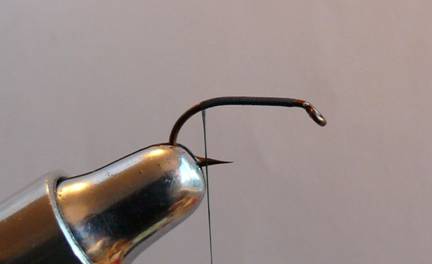 Step 1: Lay a thread base to the bend of the hook
Step 1: Lay a thread base to the bend of the hook
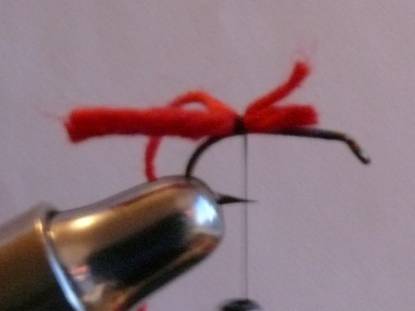 Step 2: Tie in a strip of red wool yarn. The tail is quite long, about
the length of the hook shank. The wool should extend the length of the body,
so leave a couple mm for the head. Also, tie in a single strand of yarn after
unwinding a full strip. This will be used as a rib.
Step 2: Tie in a strip of red wool yarn. The tail is quite long, about
the length of the hook shank. The wool should extend the length of the body,
so leave a couple mm for the head. Also, tie in a single strand of yarn after
unwinding a full strip. This will be used as a rib.
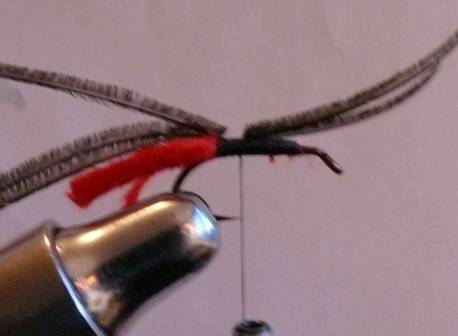 Step 3: Wrap the thread forward and back, compressing the wool with tight
wraps. Tie in 3 strands of peacock hurl. Tie in a inch or two down from the
tips, where the hurl is fragile and likely to break when you wrap it.
Step 3: Wrap the thread forward and back, compressing the wool with tight
wraps. Tie in 3 strands of peacock hurl. Tie in a inch or two down from the
tips, where the hurl is fragile and likely to break when you wrap it.
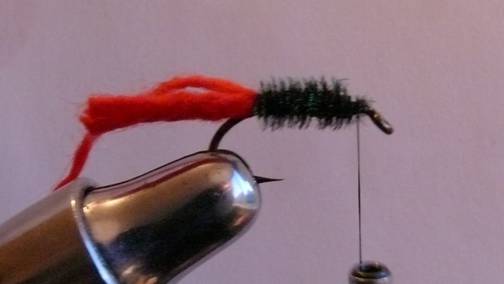 Step 4: Wrap the thread forward to where the body ends. Twist the hurl into a
rope (2 or 3 twists will be enough) and wrap the body in the same direction you
wrap your thread.
Step 4: Wrap the thread forward to where the body ends. Twist the hurl into a
rope (2 or 3 twists will be enough) and wrap the body in the same direction you
wrap your thread.
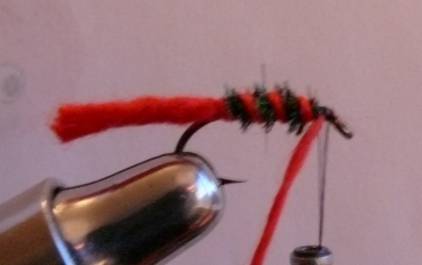 Step 5: Use the single strand of yarn to counter wrap a rib. Twist the yarn
to tighten up the strand, which will help compress it. Wrap the rib in the
opposite direction from the body and your thread. When you tie it off, to
a few turns, then turn the rib back towards the body and do a few turns over
that. This will help “lock” it in. Since we ended the wool body
back from the eye, we have room to “bulk up” here without making
an unsightly bulge at the head.
Step 5: Use the single strand of yarn to counter wrap a rib. Twist the yarn
to tighten up the strand, which will help compress it. Wrap the rib in the
opposite direction from the body and your thread. When you tie it off, to
a few turns, then turn the rib back towards the body and do a few turns over
that. This will help “lock” it in. Since we ended the wool body
back from the eye, we have room to “bulk up” here without making
an unsightly bulge at the head.
 Step 6: Tie a peacock neck feather in by the tip. Pull the fibres back to make
it easy to tie in. Bring the thread back up against the edge of the body. We’ll
wrap the hackle in front of the thread, and then bring the thread through to
help strengthen the hackle.
Step 6: Tie a peacock neck feather in by the tip. Pull the fibres back to make
it easy to tie in. Bring the thread back up against the edge of the body. We’ll
wrap the hackle in front of the thread, and then bring the thread through to
help strengthen the hackle.
Step 7: Wrap the hackle, stroking the fibres back over the fly on each turn. Bring the thread forward through the hackles to help bind them all in place (being careful to come between the fibres, not over them) Tie down the stem, fold it back towards the body and tie over (like we did with the rib).
Step 8: Trim the stem, cover the tip with thread while making a neat head.
Whip finish, and cement. Note how the hackle fibres come to about the tip
of the tail. The hackle fibres are longer than are typical in a soft hackle
pattern, and you should be thinking more along the lines of a spey fly. Rough
up the tail, and be proud of your Goat’s Toe! Tight lines!
Jeff Hamm, Auckland, New Zealand
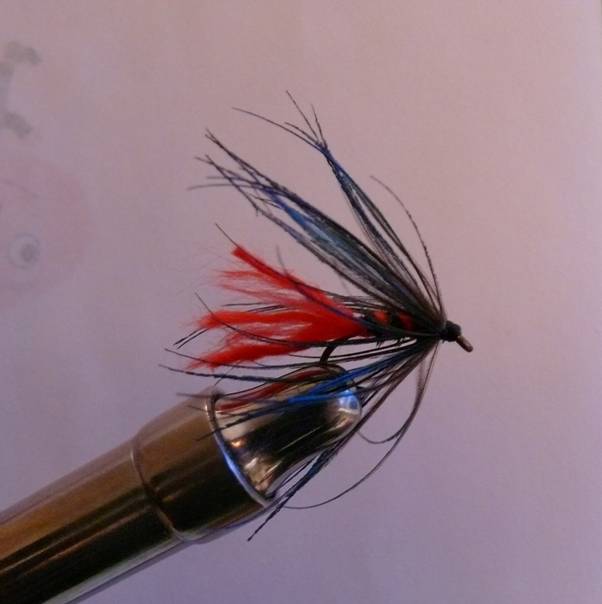
Fly of the week Archives
For more great flies, check out: Beginning Fly Tying, Intermediate Fly Tying and Advanced Fly Tying.
[ HOME ]
[ Search ] [ Contact FAOL ] [ Media Kit ]